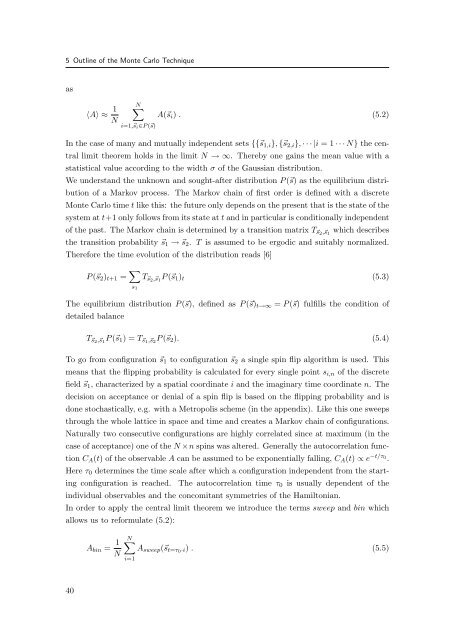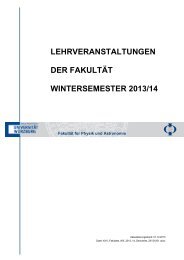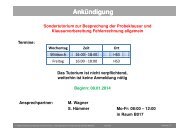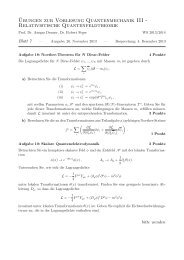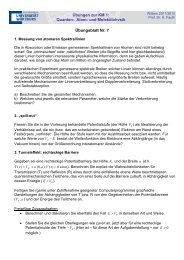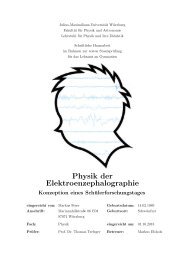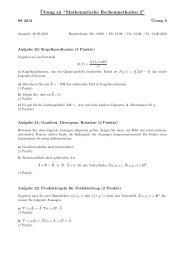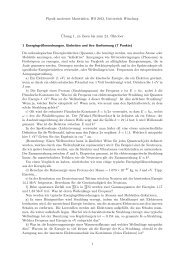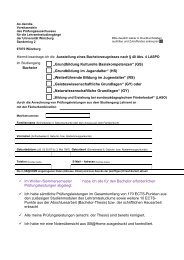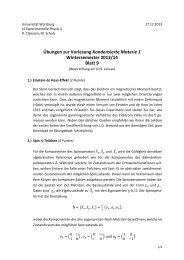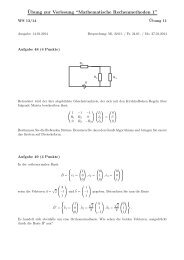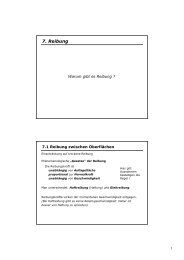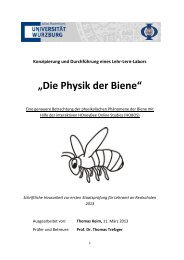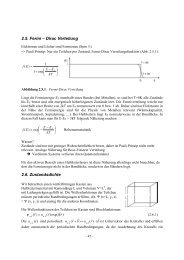Magnetic Field Induced Semimetal-to-Canted-Antiferromagnet ...
Magnetic Field Induced Semimetal-to-Canted-Antiferromagnet ...
Magnetic Field Induced Semimetal-to-Canted-Antiferromagnet ...
Create successful ePaper yourself
Turn your PDF publications into a flip-book with our unique Google optimized e-Paper software.
5 Outline of the Monte Carlo Technique<br />
as<br />
〈A〉 ≈ 1<br />
N<br />
N�<br />
i=1,�si∈P (�s)<br />
A(�si) . (5.2)<br />
In the case of many and mutually independent sets {{�s1,i}, {�s2,i}, · · · |i = 1 · · · N} the cen-<br />
tral limit theorem holds in the limit N → ∞. Thereby one gains the mean value with a<br />
statistical value according <strong>to</strong> the width σ of the Gaussian distribution.<br />
We understand the unknown and sought-after distribution P (�s) as the equilibrium distri-<br />
bution of a Markov process. The Markov chain of first order is defined with a discrete<br />
Monte Carlo time t like this: the future only depends on the present that is the state of the<br />
system at t+1 only follows from its state at t and in particular is conditionally independent<br />
of the past. The Markov chain is determined by a transition matrix T�s2,�s1 which describes<br />
the transition probability �s1 → �s2. T is assumed <strong>to</strong> be ergodic and suitably normalized.<br />
Therefore the time evolution of the distribution reads [6]<br />
P (�s2)t+1 = �<br />
s1<br />
T�s2,�s1 P (�s1)t<br />
(5.3)<br />
The equilibrium distribution P (�s), defined as P (�s)t→∞ = P (�s) fulfills the condition of<br />
detailed balance<br />
T�s2,�s1 P (�s1) = T�s1,�s2 P (�s2). (5.4)<br />
To go from configuration �s1 <strong>to</strong> configuration �s2 a single spin flip algorithm is used. This<br />
means that the flipping probability is calculated for every single point si,n of the discrete<br />
field �s1, characterized by a spatial coordinate i and the imaginary time coordinate n. The<br />
decision on acceptance or denial of a spin flip is based on the flipping probability and is<br />
done s<strong>to</strong>chastically, e.g. with a Metropolis scheme (in the appendix). Like this one sweeps<br />
through the whole lattice in space and time and creates a Markov chain of configurations.<br />
Naturally two consecutive configurations are highly correlated since at maximum (in the<br />
case of acceptance) one of the N ×n spins was altered. Generally the au<strong>to</strong>correlation func-<br />
tion CA(t) of the observable A can be assumed <strong>to</strong> be exponentially falling, CA(t) ∝ e −t/τ0 .<br />
Here τ0 determines the time scale after which a configuration independent from the start-<br />
ing configuration is reached. The au<strong>to</strong>correlation time τ0 is usually dependent of the<br />
individual observables and the concomitant symmetries of the Hamil<strong>to</strong>nian.<br />
In order <strong>to</strong> apply the central limit theorem we introduce the terms sweep and bin which<br />
allows us <strong>to</strong> reformulate (5.2):<br />
40<br />
Abin = 1<br />
N<br />
N�<br />
Asweep(�st=τ0·i) . (5.5)<br />
i=1


